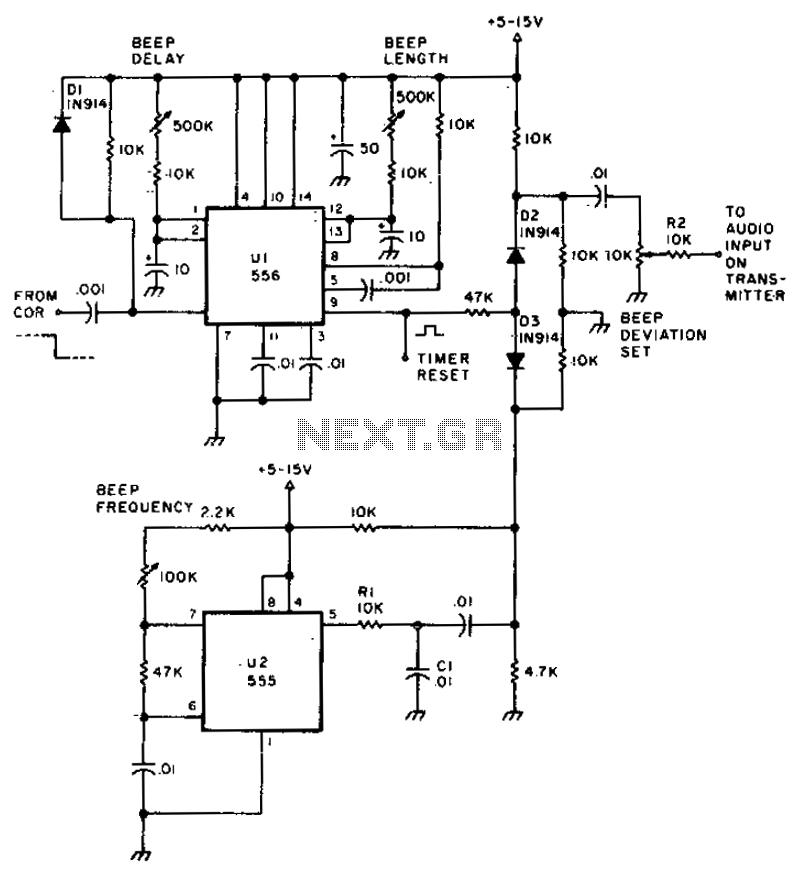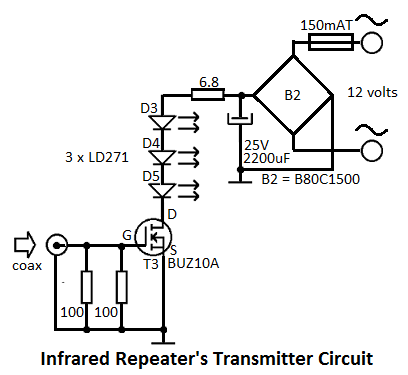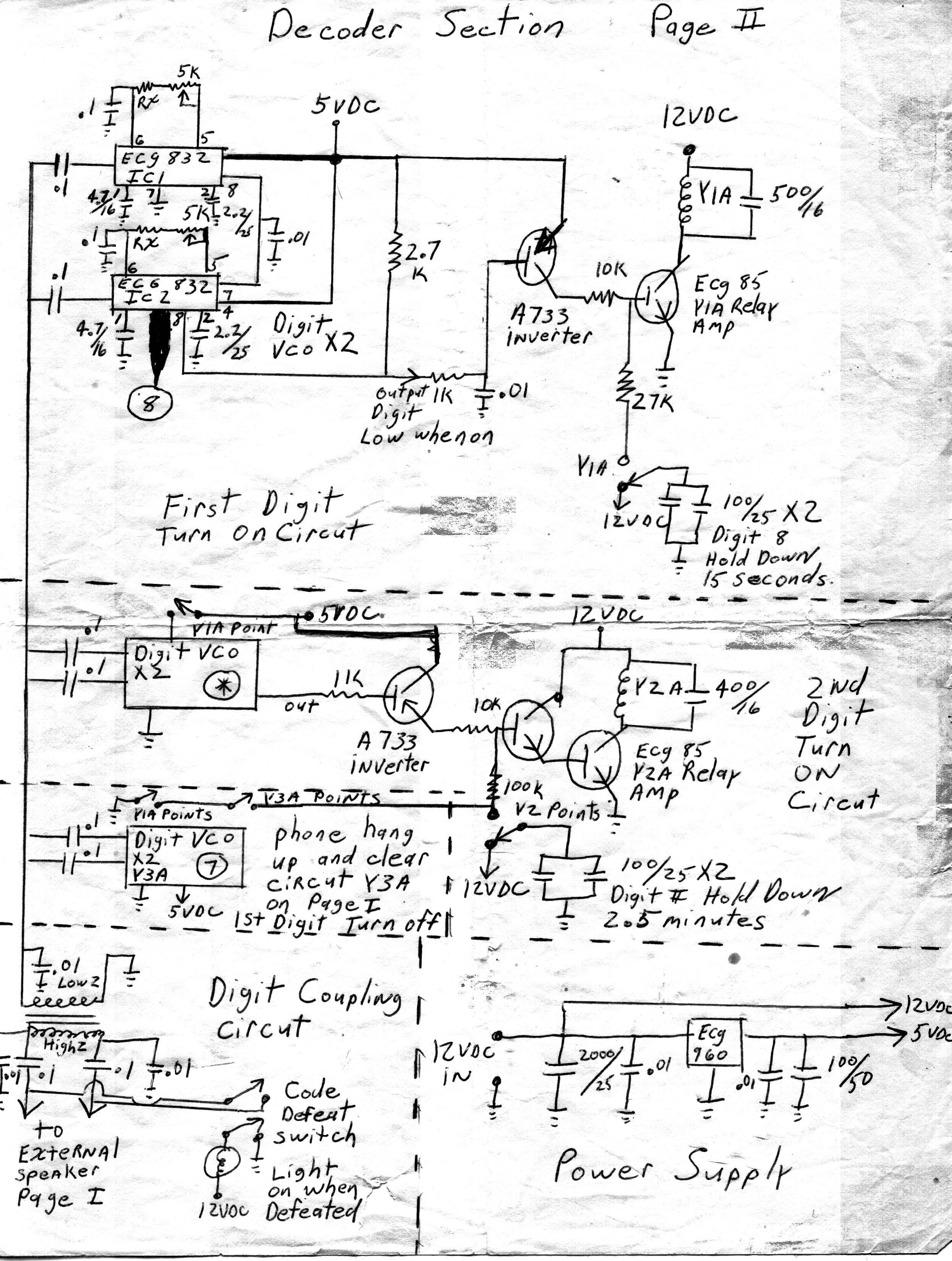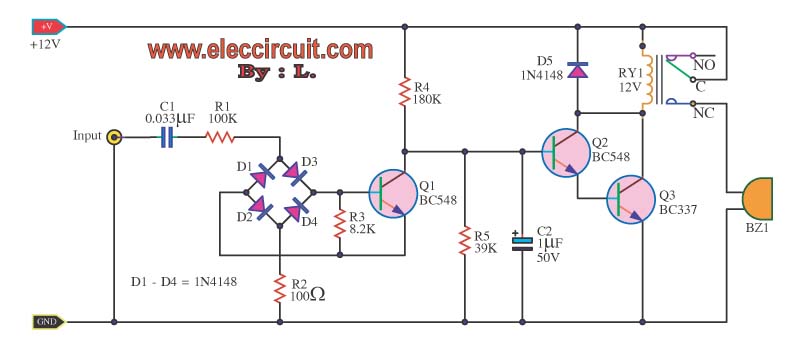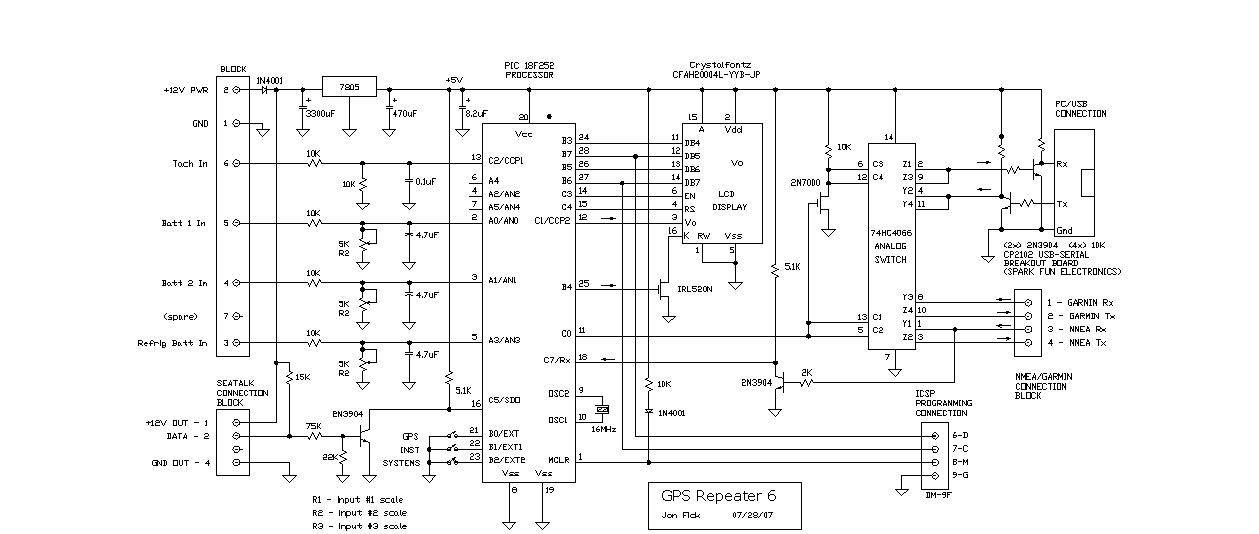
RC5 Repeater
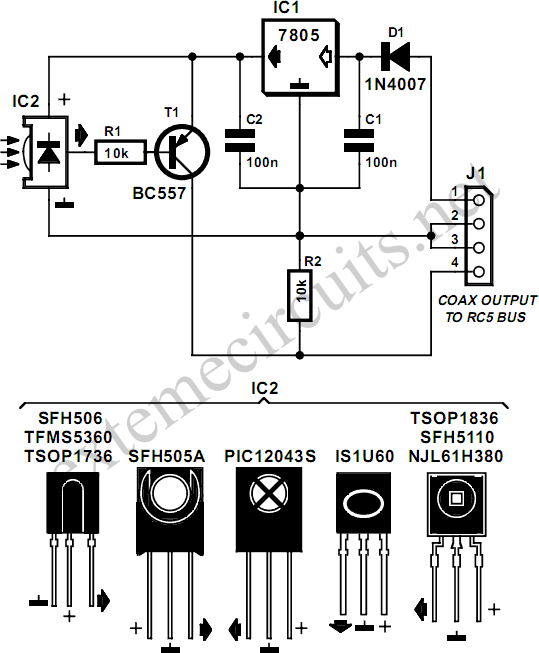
The designer of this circuit installed two waterproof loudspeakers in the bathroom and connected them to the living room stereo system using a long cable. This setup led to the desire for remote control functionality from the bathroom. Commercial extension sets for this purpose were deemed unsatisfactory, mainly because they require an additional IR transmitter diode to be placed in front of the amplifier. The repeater described here, although needing a length of coaxial cable, offers a simpler and more reliable solution. The signal from the remote control unit is received by IR receiver IC2, and the nearly open-collector output of transistor T1 is connected to the RC5 bus of the stereo system. This configuration has been found to work excellently with Philips equipment and may also be compatible with equipment from other manufacturers with minor modifications. Voltage regulator IC1 allows the supply voltage to vary between 8V and 30V, while diode D1 protects against reverse-polarity connections. An additional benefit is that the loudspeakers (Conrad models) feature transparent cones and protective grilles with large openings, enabling the tiny circuit, built on a prototyping board, to be mounted behind the cone of one speaker. This arrangement conceals the circuit while allowing the remote control to function effectively when aimed at the speakers.
The circuit utilizes an IR receiver (IC2) that detects signals from a remote control unit, which is essential for enabling remote operation of the stereo system from the bathroom. The output of the IR receiver is connected to a transistor (T1), which acts as a switch to transmit the received IR signals to the RC5 bus of the stereo system. The RC5 protocol is widely used in consumer electronics, particularly in Philips devices, making this circuit highly compatible. The use of a voltage regulator (IC1) ensures that the circuit operates correctly across a range of supply voltages, enhancing its versatility and ease of integration into various setups.
Diode D1 is included in the design to safeguard the circuit against potential damage caused by incorrect power supply connections. This protection feature is crucial in preventing reverse polarity, which could lead to circuit failure. The choice of waterproof loudspeakers is particularly advantageous in a bathroom environment, where humidity and splashes are concerns. The transparent cones of the loudspeakers not only allow for aesthetic integration of the circuit but also ensure that the remote control signals can pass through without obstruction, maintaining functionality.
Overall, this circuit design addresses the need for extended remote control capabilities in a unique setting while providing a reliable and aesthetically pleasing solution. The compact nature of the circuit allows for discreet installation, and its adaptability to different equipment makes it a valuable addition to any home audio system.The designer of this circuit had fitted two (waterproof) loudspeakers in his bathroom and connected them to the stereo system in the living room via a long cable. Naturally, this promptly led to the desire to be able to use the remote control unit from the bathroom.
Commercially available extension sets for this purpose were judged to be unsatisfa ctory, primarily because they require an additional IR transmitter diode to be fitted in front of the amplifier. Although the repeater shown here requires a length of coaxial cable, it provides a simpler, and above all more reliable, solution to the problem.
The signal transmitted by the remote control unit is received by IR receiver IC2, and the (nearly) open-collector output of T1 is connected to the RC5 bus of the stereo system. This proved to work excellently with Philips equipment, and it will probably also work with equipment from other manufacturers with a few small modifications.
Voltage regulator IC1 is used here to allow the supply voltage to range from 8V to 30V, and diode D1 provides protection against a reverse-polarity supply voltage connection. A nice side benefit arose from the fact that the loudspeakers in question (Conrad models) have transparent cones and protection grilles with rather large openings.
This made it possible tot the tiny circuit, which was built on a piece of prototyping board, to the frame of one of the speakers, behind the cone. The whole arrangement is thus hidden, but the remote control still works perfectly if it is aimed towards the speakers.
🔗 External reference
The circuit utilizes an IR receiver (IC2) that detects signals from a remote control unit, which is essential for enabling remote operation of the stereo system from the bathroom. The output of the IR receiver is connected to a transistor (T1), which acts as a switch to transmit the received IR signals to the RC5 bus of the stereo system. The RC5 protocol is widely used in consumer electronics, particularly in Philips devices, making this circuit highly compatible. The use of a voltage regulator (IC1) ensures that the circuit operates correctly across a range of supply voltages, enhancing its versatility and ease of integration into various setups.
Diode D1 is included in the design to safeguard the circuit against potential damage caused by incorrect power supply connections. This protection feature is crucial in preventing reverse polarity, which could lead to circuit failure. The choice of waterproof loudspeakers is particularly advantageous in a bathroom environment, where humidity and splashes are concerns. The transparent cones of the loudspeakers not only allow for aesthetic integration of the circuit but also ensure that the remote control signals can pass through without obstruction, maintaining functionality.
Overall, this circuit design addresses the need for extended remote control capabilities in a unique setting while providing a reliable and aesthetically pleasing solution. The compact nature of the circuit allows for discreet installation, and its adaptability to different equipment makes it a valuable addition to any home audio system.The designer of this circuit had fitted two (waterproof) loudspeakers in his bathroom and connected them to the stereo system in the living room via a long cable. Naturally, this promptly led to the desire to be able to use the remote control unit from the bathroom.
Commercially available extension sets for this purpose were judged to be unsatisfa ctory, primarily because they require an additional IR transmitter diode to be fitted in front of the amplifier. Although the repeater shown here requires a length of coaxial cable, it provides a simpler, and above all more reliable, solution to the problem.
The signal transmitted by the remote control unit is received by IR receiver IC2, and the (nearly) open-collector output of T1 is connected to the RC5 bus of the stereo system. This proved to work excellently with Philips equipment, and it will probably also work with equipment from other manufacturers with a few small modifications.
Voltage regulator IC1 is used here to allow the supply voltage to range from 8V to 30V, and diode D1 provides protection against a reverse-polarity supply voltage connection. A nice side benefit arose from the fact that the loudspeakers in question (Conrad models) have transparent cones and protection grilles with rather large openings.
This made it possible tot the tiny circuit, which was built on a piece of prototyping board, to the frame of one of the speakers, behind the cone. The whole arrangement is thus hidden, but the remote control still works perfectly if it is aimed towards the speakers.
🔗 External reference
